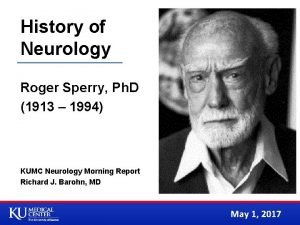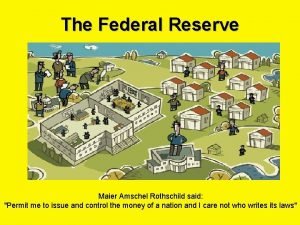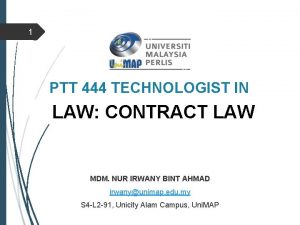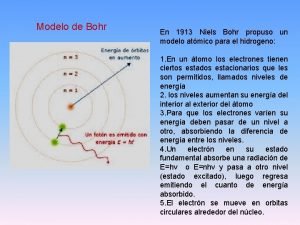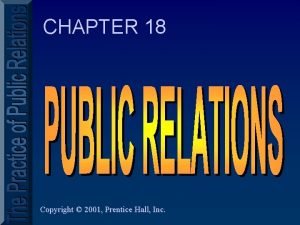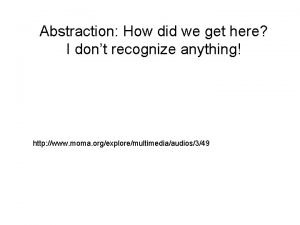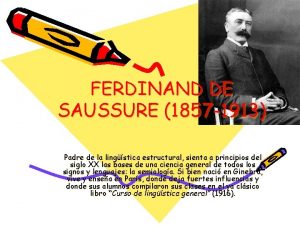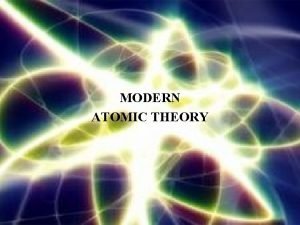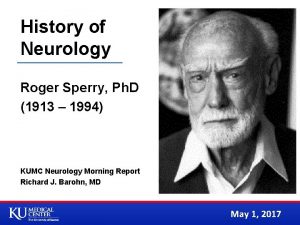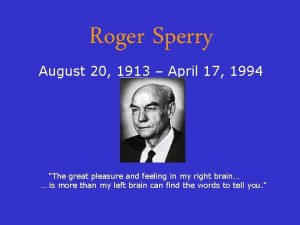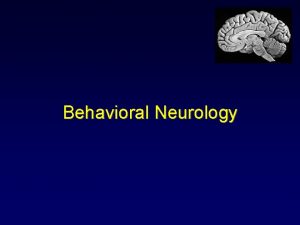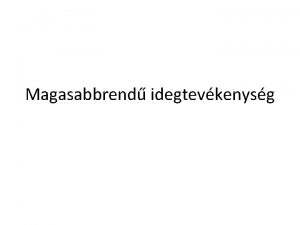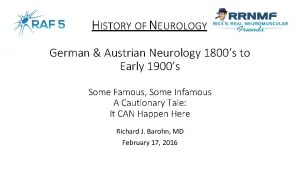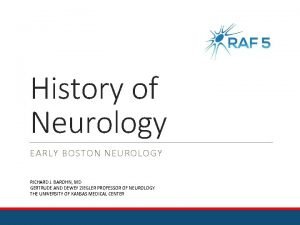History of Neurology Roger Sperry Ph D 1913










- Slides: 10

History of Neurology Roger Sperry, Ph. D (1913 – 1994) KUMC Neurology Morning Report Richard J. Barohn, MD May 1, 2017

Roger Sperry, Ph. D (1913 – 1994) Biography YEAR ACHIEVEMENT 1913 Born in Hartford, CT 1935 Oberlin College, OH • Majored in English, but took Intro To Psychology • R. H. Stenson, who worked with William James 1937 Masters in Psychology; Oberlin College 1941 Ph. D in Zoology; Univ of Chicago 1942 Post Doc; Harvard with Karl Lashley and at Primate Research Center in FL 1946 Faculty in Dept of Anatomy at Univ of Chicago; Assistant then Associate 1954 Professor in Psychobiology at California Institute of Technology • Experiments with Joseph Brogden, MD & many others (Michael Gazaniga)

Split Brain Experiments, Lateralization of Brain Functions § In cats and monkeys first § Cut optic nerves in the eye, so left eye connected to left hem and right connected to right hem § Also cut corpus callousness § Taught to distinguish triangle from square with right eye covered § Then presented same problem with left eye covered § Showed left and right hemispheres functions separately when not connected by corpus callous

Split Brain Experiments, Lateralization of Brain Functions § § In humans undergoing corpus callous splitting for intractable epilepsy Present word to either left or right visual field If presented to right visual field, image processing left hemisphere If presented to left visual field (right hem) the patient could not report seeing the word, only left side of brain could articulate speech

Another Experiment § § § Presented on a object to the left visual field and a different object to the right visual field in split brain patients The patients left hand under a partition and patients asked to draw with their left hand what they had been shown Patients would draw what they had seen in left visual field, when shown what they had drawn would describe what had been shown in right visual field Proved when corpus callosum was severed it breaks connection between left and right hemispheres, making them unable to communicate with each other. Patients has no idea that the other hemispheres even exists “indeed a conscious system in its own right, perceiving, thinking, remembering, reasoning, willing, and emoting, all at a characteristically human level, and. . both the left and the right hemisphere may be conscious simultaneously in a different, even in a mutually conflicting, mental experience that runs along in parallel” - Sperry 1974

Chemoaffinity Hypothesis § § § Early experiments at U Chicago Crosswire the motor nerves of rats legs so left nerve controlled the right leg and vice versa Placed rats in a cage that had electric grid on bottom separated in to four sections Each leg of the rat placed into one of the 4 grids Shock administered to a specific section of the gird § Ex) the gird for rats left back leg would get a shock § So every time left paw was shocked the rat would lift its right paw and vice versa § § Wanted to know how long it would take the rat to realize he was lifting the wrong paw Rats never learned to lift up the correct paw § Some things are hard wired and cannot be relearned § No adaptive functioning of the nervous system

Chemoaffinity Hypothesis § § Experiments with Optics in salamanders with Lashley at Harvard Sectioned nerves and rotated eye 180 degrees Would vision be normal after regeneration, or would animal forever view world as “upside down” and right-left reversed? § § § If later was the case, means the nerves were guided back to the original sites of termination Restoration of normal vision (seeing the world “right-side up”) would mean the regenerating nerves had terminated in new sites But the animal reacted as though the world was upside down and reversed right to left No amount of training could change the response Evidence for nerve guidance by “intricate chemical under generic control” (1963) and the chemoaffinity hypothesis

Chemoaffinity Hypothesis § “The cells and fibers of the brain must carry some kind of individual identification tags, presumably cytochemical in nature, by which are distinguished from one another almost, in many regions, to the level of the single neurons. ” - Sperry § “He suggested that gradients of such identification tags or retinal neuro an and on the target cell sin the brain coordinator lay guide the orderly projection of millions of developing retinal axons. ” - Science 2009

Roger Sperry, Ph. D 1971 1979 • California Scientist of The Year • Wolfe Price in Medicine • Albert Lasker Medical Research Award • Nobe Prize in Physiology of Medicine 1981 • Shared with Hubel & Wiesel 1989 • National Medal of Science Nobel prize ceremony - 1981

“The great pleasure and feeling in my right brain is more than my left brain can find the words to tell you. ” – Roger Sperry
